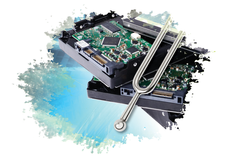Speeding up slow disks with SSD caching
Afterburner

Flash memory is fast but also expensive. Caching with Flash provides a way out: A smaller and cheaper SSD can speed up the disk.
Hard disks are inexpensive, and they have huge capacities, but they are also slow. Solid state disks (SSDs) are fast, but smaller and more expensive. If you combine the advantages of a hard disk with an SSD-based cache, you pick up a large performance gain at a reasonable cost.
An application generally does not want all the data at once; most of the data is in the state of being ignored most of the time. Caching lets you move the most frequently requested data to an exclusive, fast medium and leave the less-frequently accessed data on the cheaper but slower background medium.
The Linux environment has several tools that provide the necessary software to support hard-disk caching. Does it help to use an SSD-based flash drive as a cache for a traditional hard disk? We decided to find out. This article explores the possibilities for caching with the Linux caching tools Enhance IO and dm-cache. If you are new to the topic of caching, and you would like some additional information on choices you might have to make, see the boxes titled "A Little Cache Theory" and "How Flash Works."
[...]
Buy this article as PDF
(incl. VAT)
Buy Linux Magazine
Subscribe to our Linux Newsletters
Find Linux and Open Source Jobs
Subscribe to our ADMIN Newsletters
Support Our Work
Linux Magazine content is made possible with support from readers like you. Please consider contributing when you’ve found an article to be beneficial.

News
-
Two New Distros Adopt Enlightenment
MX Moksha and AV Linux 25 join ranks with Bodhi Linux and embrace the Enlightenment desktop.
-
Solus Linux 4.8 Removes Python 2
Solus Linux 4.8 has been released with the latest Linux kernel, updated desktops, and a key removal.
-
Zorin OS 18 Hits over a Million Downloads
If you doubt Linux isn't gaining popularity, you only have to look at Zorin OS's download numbers.
-
TUXEDO Computers Scraps Snapdragon X1E-Based Laptop
Due to issues with a Snapdragon CPU, TUXEDO Computers has cancelled its plans to release a laptop based on this elite hardware.
-
Debian Unleashes Debian Libre Live
Debian Libre Live keeps your machine free of proprietary software.
-
Valve Announces Pending Release of Steam Machine
Shout it to the heavens: Steam Machine, powered by Linux, is set to arrive in 2026.
-
Happy Birthday, ADMIN Magazine!
ADMIN is celebrating its 15th anniversary with issue #90.
-
Another Linux Malware Discovered
Russian hackers use Hyper-V to hide malware within Linux virtual machines.
-
TUXEDO Computers Announces a New InfinityBook
TUXEDO Computers is at it again with a new InfinityBook that will meet your professional and gaming needs.
-
SUSE Dives into the Agentic AI Pool
SUSE becomes the first open source company to adopt agentic AI with SUSE Enterprise Linux 16.

